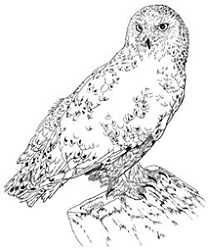
Scientific Name: Bubo scandiaca, formerly Nyctea scandiaca
A large owl found circumpolar in the northern hemisphere. Similar in size to the Great Horned Owl (Bubo virginianus), but primarily white for camouflage in snowy environments. Males are almost pure white, with some light bars or spots of dusky brown. Females and juvenile owls show much more brown barring and spots. Females are significantly larger than males. The ear tufts of this owl are indistinguishable but present.
The eyes seem small for an owl, but the brilliant golden irises are striking against the white plumage. The beak and talons are dark in color and heavily feathered. Plumage is highly insulative for protection against extreme arctic cold. This species has both highly acute vision and hearing. It can locate prey visually from a great distance, or acoustically through deep snow. Snowy owls are considered crepuscular but can often be seen hunting during daylight.
Male
Length: 20 – 27″
Wingspan: 55 – 66″
Weight: 58.5 oz. ave.
Female
Length: 20 – 27″
Wingspan: 55 – 66″
Weight: 61.5 oz. ave.
The snowy owl is both state and federally protected. The numbers of birds in the wild are not well known due to their extreme habitat but centuries of taking these birds as trophies and as food items has decreased their numbers.
Open arctic terrain from tree line to the polar seas. Prefers high rolling tundra with numerous promontories for perching and nest sites. Areas chosen as habitat by the snowy owl are often more vegetated than surrounding areas due to the additional nitrogen added to the soil by the birds. Habitat choice seems primarily based on prey availability.
Diet consists of lemmings, voles and other small rodents to mammals as large as hares but will also take medium size song birds to medium size geese. Ptarmigan and other open country birds will be targeted as well, especially when plentiful. Snowy owls often pursue prey in a strong, steady flight but they are also known to pounce on prey from perches.
Males are more vocal than females. Call a deep and muffled brooo which is often repeated in a series. When threatened, makes a quock, quawk. Females sometimes whistle or make a mewing sound.
Nests on bare ground in shallow holes from sea level to an elevation of less than 300m. These owls prefer a prominent spot with view of their surroundings that is often times windy but snow free. Studies have shown that snow free nest spots correlate highly with nest success for this species. Often prey species will be abundant in the nest site area.
This species faces human persecution in most of its range. Humans have been shooting and trapping this species for food and for trophy hunting for centuries. During migration they face threat from hitting cars, electrocution and airplane strike, as one of their favored haunts is the open terrain around airports.

Found circumpolar in the northern hemisphere. Primarily found in open terrain of the artic. Breeds into southern Canada and northern United States (Alaska) but winter migrations have periodically brought individuals as far south as central California and the Gulf states. Migratory movements are not well understood but may be related to abundance of prey species (primarily small rodents). Some banded individuals are regular migrants with no correlation to prey cycles.
Special Thanks for range maps:
Dan Gleason
BGleason Design & Illustration
Commercial & Scientific Illustration, Graphic Design
CraneDance Communications
Book Production/Design

